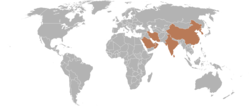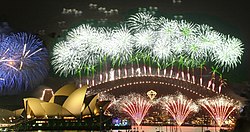New Year's Day
New Year's Day is a holiday in many countries. It was made to welcome the new year. In most countries, New Year's Day is celebrated on 1 January. This holiday is celebrated the most, with over 200 countries and territories in the world that observe it.
| New Year's Day | |
|---|---|
 Fireworks in Mexico City at the stroke of midnight on New Year's Day, 2013 | |
| Observed by | Users of the Gregorian calendar |
| Significance | The first day of the Gregorian year |
| Date | 1 January |
| Celebrations | Making New Year's resolutions, church services, parades, sporting events, fireworks[1] |
| Related to | New Year's Eve, Christmastide |
The new year is an event that happens when a culture celebrates the end of one year and the beginning of the next. Cultures that measure yearly calendars all have new year celebrations.
Modern new year celebrations
| Date | Celebration |
|---|---|
| 1 January | Christian New Year |
| 14 January | Eastern Orthodox New Year |
| 22 January | Chinese New Year (also known as the lunar year. It takes place every year on the first lunar month) |
| 22 January | Vietnamese New Year (also known as the Tết Nguyên Đán) |
| January to March | Tibetan New Year |
| 14 March | Sikh / Nanakshahi New Year (also called Hola Mohalla) |
| 20 or 21 March | Iranian New Year (also called Norouz. It is the day containing the exact moment of the vernal equinox) |
| 19, 20, 21 or 22 March | Bahá'í New Year (also called Naw-Rúz. It is the day (starting at the previous sunset) in Tehran containing the exact moment of the vernal equinox) |
| 1 April | Assyrian New Year (also called Rish Nissanu) |
| 13 or 14 April | Tamil New Year |
| March or April | Telugu New Year |
| 13 April | Punjabi New Year (also called Vaisakhi and celebrates the harvest) |
| 13 to 15 April | Thai New Year (celebrated by throwing water) |
| 13 or 14 April | Sri Lankan New Year (when the sun moves from the Meena Rashiya (House of Pisces) to the Mesha Rashiya (House of Aries)) |
| 13 to 15 April | Cambodian New Year |
| 14 or 15 April | Bengali New Year (also called Pohela Baisakh) |
| October or November | Gujarati New Year |
| October or November | Marwari New Year |
| Muharram 1 | Islamic New Year |
Historical dates for the new year
Early Christmas
In Christmas Style dating, the new year started on 25 December. This was used in Germany[2] and England until the thirteenth century, and in Spain from the fourteenth to the sixteenth century.
In Annunciation Style dating the new year started on 25 March, the feast of the Annunciation. This was used in many parts of Europe in the Middle Ages. The style was started by Dionysius Exiguus in AD 525. Annunciation Style was used in England until 1 January 1752, and in Scotland until 1 January 1600, when the kingdom of Scotland changed to Circumcision Style. England, the kingdom of Ireland, and the Thirteen Colonies changed to Circumcision Style on 1 January, after the United Kingdom of Great Britain changed from the Julian calendar to the Gregorian calendar on 3/14 September 1752. This happened because the Parliament of Great Britain made an act of parliament, the Calendar (New Style) Act 1750.
New Year's Day Media
Fireworks in London on New Year's Day at the stroke of midnight
Sydney contributes to some of the major New Year celebrations each year.
New Year's fireworks in front of the Helsinki Cathedral in Helsinki, Finland, about one minute past midnight on New Year's Day in 2016.
References
- ↑ Mehra, Komal (2006). Festivals of the World. Sterling Publishers. p. 69. ISBN 9781845575748.
In many European countries like Italy, Portugal and Netherlands, families start the new year by attending church services and then calling on friends and relatives. Italian children receive gifts or money on New Year's Day. People in the United States go to church, give parties and enjoy other forms of entertainment.
- ↑ "Saying Happy New Year In German". www.events2021.com. Archived from the original on 26 February 2021. Retrieved 30 December 2019.
| Wikimedia Commons has media related to Lua error in Module:Commons_link at line 62: attempt to index field 'wikibase' (a nil value).. |
Other websites
- New Year's Around the World Archived 2011-01-03 at the Wayback Machine – slideshow by Life magazine
 . New International Encyclopedia. 1905.
. New International Encyclopedia. 1905. {{cite encyclopedia}}: Cite has empty unknown parameter:|HIDE_PARAMETER=(help)



